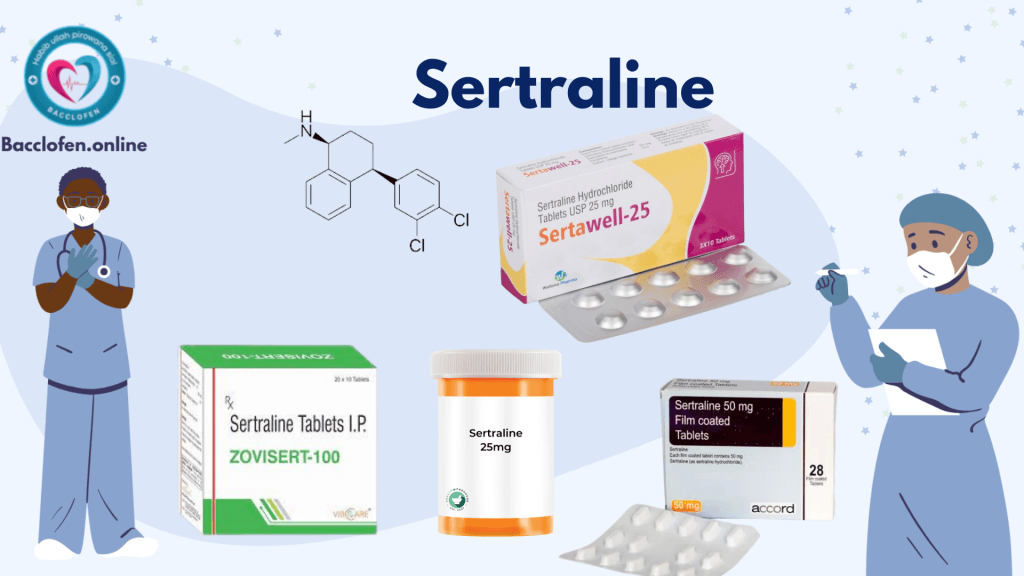Sertraline is a widely prescribed antidepressant that belongs to the class of drugs known as selective serotonin reuptake inhibitors (SSRIs). It is primarily used to treat a range of mood and anxiety disorders, helping patients achieve emotional balance and improved quality of life. With its well-established efficacy and safety profile, sertraline has become a cornerstone in mental health treatment.
This guide provides a detailed overview of sertraline, including its uses, benefits, potential side effects, dosage guidelines, and precautions for safe use.
What Is Sertraline?
Sertraline is an SSRI that works by increasing the levels of serotonin in the brain. Serotonin is a neurotransmitter that plays a crucial role in regulating mood, anxiety, and overall emotional well-being. By preventing the reabsorption (reuptake) of serotonin into neurons, sertraline helps enhance and prolong the effects of serotonin, leading to improved mood and reduced symptoms of anxiety and depression.
First approved by the FDA in 1991, sertraline has since gained widespread use and is considered a first-line treatment for several psychiatric disorders.
Uses of Sertraline
Sertraline is used to treat a variety of mental health conditions, including:
1. Depression
- Effective in treating major depressive disorder (MDD), helping to alleviate symptoms such as sadness, loss of interest, fatigue, and difficulty concentrating.
2. Anxiety Disorders
- Includes generalized anxiety disorder (GAD), social anxiety disorder (SAD), and panic disorder. Sertraline helps reduce excessive worry, fear, and physical symptoms like heart palpitations.
3. Obsessive-Compulsive Disorder (OCD)
- Reduces the frequency and severity of obsessive thoughts and compulsive behaviors.
4. Post-Traumatic Stress Disorder (PTSD)
- Helps manage symptoms such as flashbacks, nightmares, and hypervigilance, improving overall functioning.
5. Premenstrual Dysphoric Disorder (PMDD)
- Alleviates severe emotional and physical symptoms associated with the menstrual cycle.
6. Other Conditions
- May be used off-label for conditions like eating disorders and chronic pain syndromes.

Benefits of Sertraline
Sertraline offers several key benefits, making it a preferred choice for many patients:
1. Proven Efficacy
- Supported by extensive clinical research demonstrating its effectiveness in treating a variety of mood and anxiety disorders.
2. Favorable Safety Profile
- Generally well-tolerated with a lower risk of severe side effects compared to older antidepressants like tricyclics or MAO inhibitors.
3. Non-Sedating
- Unlike some other medications, sertraline does not cause significant sedation, making it suitable for daytime use.
4. Versatile Use
- Effective across a wide range of psychiatric conditions, providing comprehensive symptom relief.
Dosage and Administration
The dosage of sertraline varies based on the condition being treated and individual patient factors. Below are general guidelines:
Adults:
- Depression and Anxiety Disorders:
- Initial dose: 25–50 mg once daily.
- Maintenance dose: 50–200 mg once daily.
- Obsessive-Compulsive Disorder (OCD):
- Initial dose: 50 mg once daily.
- Maximum dose: 200 mg once daily.
- Post-Traumatic Stress Disorder (PTSD) and PMDD:
- Starting dose: 25–50 mg once daily, adjusted based on response.
Children and Adolescents:
- OCD:
- Initial dose: 25 mg once daily (ages 6–12).
- Dose may be gradually increased to a maximum of 200 mg daily under medical supervision.
Special Populations:
- Lower initial doses may be recommended for older adults or individuals with liver impairment.
Side Effects of Sertraline
While sertraline is generally well-tolerated, it can cause side effects, particularly during the initial stages of treatment or when dosages are adjusted.
1. Common Side Effects:
- Nausea
- Diarrhea
- Insomnia
- Dry mouth
- Fatigue
- Dizziness
2. Less Common Side Effects:
- Increased sweating
- Tremors
- Weight changes (gain or loss)
- Sexual dysfunction (e.g., reduced libido, difficulty achieving orgasm)
3. Rare but Serious Side Effects:
- Serotonin Syndrome: A potentially life-threatening condition caused by excessive serotonin levels, characterized by agitation, confusion, rapid heart rate, and high fever.
- Suicidal Thoughts: Increased risk, particularly in children, adolescents, and young adults during the initial treatment phase.
- Allergic Reactions: Severe reactions may include swelling, difficulty breathing, or rash.
If any serious side effects occur, discontinue use and seek immediate medical attention.
Precautions for Safe Use
To ensure the safe and effective use of sertraline, patients should follow these precautions:
1. Avoid Abrupt Discontinuation:
- Stopping sertraline suddenly can cause withdrawal symptoms such as irritability, dizziness, and flu-like symptoms. Always taper off under medical supervision.
2. Monitor Drug Interactions:
- Sertraline can interact with medications such as:
- Monoamine Oxidase Inhibitors (MAOIs): Can lead to serotonin syndrome; a 14-day gap is required before switching.
- Blood Thinners (e.g., warfarin): May increase the risk of bleeding.
- Other SSRIs or SNRIs: Increases the risk of serotonin syndrome.
3. Pregnancy and Breastfeeding:
- Generally considered safe during pregnancy but should be used under medical supervision. Can pass into breast milk, so benefits and risks should be weighed for breastfeeding mothers.
4. Special Populations:
- Use with caution in individuals with a history of bipolar disorder, epilepsy, or liver disease.
Tips for Effective Use
- Take Consistently:
- Take sertraline at the same time each day, with or without food, to maintain consistent blood levels.
- Be Patient:
- Therapeutic effects may take 4–6 weeks to become fully apparent.
- Avoid Alcohol:
- Alcohol can increase the risk of side effects and reduce the effectiveness of sertraline.
- Report Persistent Symptoms:
- Inform your healthcare provider if symptoms do not improve or worsen after several weeks of treatment.
- Stay Informed:
- Read the medication guide provided and discuss any concerns with your doctor or pharmacist.


